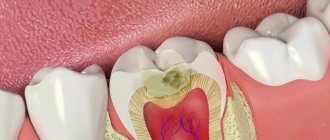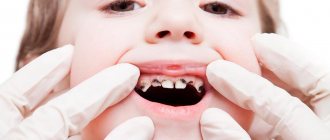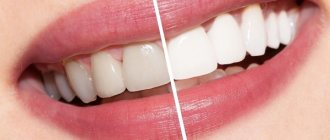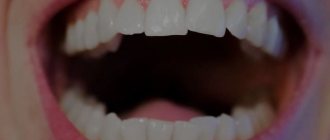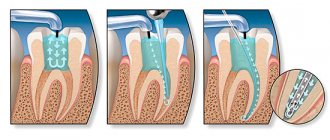From this article you will learn:
- how to properly care for your teeth,
- what is the best way to brush your teeth,
- how to protect teeth from caries.
The development of caries occurs with the participation of cariogenic bacteria in the oral cavity, which metabolize food debris stuck between the teeth after eating, turning them into lactic acid.
The acid dissolves the surface layer of tooth enamel, initially leading to the appearance of white chalky spots, which are the most initial, yet reversible, form of caries. White spots on human teeth are symptoms of the appearance of foci of demineralization of tooth enamel, in which acid has dissolved a significant part of the minerals (hydroxyapatite). If the acid attack continues for a long time, then the demineralization process reaches such a degree that the density of the enamel not only decreases, but its structural destruction occurs - a carious tooth defect is formed. The latter can be cured only by filling the tooth.
Thus, the main role in the development of caries is played by 1) microbial plaque, 2) food debris. Good regular oral hygiene can remove both of these components from teeth, but it is also important to avoid constant snacking between meals and frequent consumption of sugar-sweetened drinks. Therefore, if you are asking yourself how to get rid of tooth decay, then proper regular oral hygiene is the most important part of protecting your teeth from tooth decay and gum disease. And below we will tell you what it should be.
Important: dental care may include not only regular teeth brushing, but also additional measures that will help you strengthen your tooth enamel even more effectively. For example, the risk of developing caries can be further reduced by remineralizing teeth (we are talking about professional and home fluoridation of teeth). And we will also talk about all this in detail below.
Will floss prevent dental caries?
A recent New York Times article[] questioned the benefits of dental floss.
A 2011 study[] found that flossing in addition to brushing reduces the risk of gum disease. And not too much, since most people don’t floss their teeth thoroughly enough.
But in the fight against enamel destruction, thread is not a help at all. There is still no evidence that regular flossing reduces the risk of tooth decay.
Reasons for appearance
The development of caries occurs when bacteria penetrate into the tooth or when they are exposed to tooth enamel for a long time. The main reason for the appearance of pathology is poor oral hygiene. Insufficiently thorough cleansing of the oral cavity from plaque, which accumulates daily, leads to its accumulation and the appearance of deposits. Bacteria “corrode” tooth enamel, penetrate into subgingival pockets and microcracks, provoking the development of an infectious process.
In addition to poor dental hygiene, other factors can cause tooth decay.
General factors.
- Deficiency of vitamins and minerals.
- Diseases of the immune system.
- Hormonal disorders.
- Diabetes.
- Effect of high or low temperatures.
- Heredity.
Local factors.
- Contains a large amount of acid in saliva.
- Weakened enamel.
- Pulp and periodontal pathologies.
- Malocclusion.
- Deviations in teething.
- Congenital anomalies of the dental system.
- Anomaly in the biochemical composition of dental bone tissue.
Excessive consumption of sweets is often attributed to the causes of tooth decay. In fact, the sugar contained in such foods does not have any negative effects if the teeth are healthy and properly cared for. Sweets that cause active production of saliva with high acidity, of course, cause caries, but only in combination with other provoking local factors.
Do I need a dental scan?
American dentists recommend having your teeth x-rayed every year. Austin Frakt, a health economist, reviewed[] medical studies and concluded that such reinsurance is unwarranted. Cavities in the tooth form more slowly—over 2–3 years.
In Russia, preventive x-rays are not so popular. But computed tomography is suggested to be done regularly. You should also not agree to this expensive service more often than once every couple of years.
Consequences
Untimely treatment of caries can lead not only to dental disease, but also to other disorders of the body:
- disorders in the immune system caused by bacteria and leading to frequent acute respiratory viral infections;
- development of various types of allergies;
- violation of the digestive system, with manifestations in the form of heartburn, the development of gastritis;
- disruption of the cardiovascular system caused by the penetration of bacteria into the circulatory system during advanced tooth damage.
In addition, we should not forget that an untreated tooth can lead to its complete destruction and removal, disrupting the aesthetic appearance and causing complexes.
Which toothpaste is more effective?
The good news is that brushing your teeth is still beneficial. But to prevent the development of caries, the paste must contain fluoride. A study of the results of dental examinations of children aged 5 to 16 years []confirmed the effectiveness of the use of this mineral for the prevention of caries and tooth loss. Moreover, it is better to brush your teeth with fluoride paste twice, not once: the positive effect will be more noticeable.
True, fluoride paste does not help against gingivitis and plaque on teeth. But it really protects against enamel destruction.
What is caries?
According to statistics, dental caries is present in every third person on earth to varying degrees.
Children mainly suffer from caries, which is explained by the weak protection of the enamel of baby teeth. The disease can occur even in young children after the first teeth erupt. In adulthood, pathology is slightly less common, since the tissues of permanent teeth are more resistant to bacterial attack. Caries is an infectious process caused by pathogenic bacteria that attack the hard tissues of teeth. At the first stage, the disease provokes demineralization of the enamel, then destroys bone tissue and at the last (deep) stage penetrates the dentin, pulp and periodontium.
Among the reasons for premature removal of milk and permanent teeth, caries ranks first. Also, dental caries is a provoking factor in the development of pathologies such as pulpitis, periodontitis, gingivitis, periodontitis, root cyst and others.
Which toothbrush is better
Electric toothbrushes are many times more expensive than regular ones. But it does seem to make sense in terms of plaque and gingivitis control.
Researchers compared the teeth of adults and children who used electric and regular toothbrushes. Within a month, it turned out that among representatives of the first group, plaque formation decreased by 11%, and after three months - by 21%. After a month of using electric toothbrushes, the incidence of gingivitis decreased by 6%, and after 3 months - by 11%.
Models with a rotating head cope best with plaque.
Sealing dental fissures as caries prevention
Fissures are natural depressions on the surface of teeth. Food debris accumulates in these pits, making it more difficult to remove plaque and germs from there during cleaning. In addition, in the fissure area, enamel mineralization is slowed down; its layer is thinner than on other surfaces of the teeth, so natural depressions are considered a risk zone for the development of carious lesions. The fissure sealing method is primarily used for children. Its essence lies in the fact that the recesses are closed with special sealants. As a result, food does not accumulate on the teeth, and the vulnerable spot of the tooth surface is reliably protected from the action of pathological microorganisms.
Is professional teeth cleaning necessary?
Some dentists recommend polishing and grinding your teeth, or professional cleaning, twice a year. However, this procedure has a number of contraindications: allergic reactions to the medications used, enamel sensitivity, bleeding gums.
In 2005, eight studies[] were conducted on the effects of professional dental cleanings on dental health. None of them even confirmed the safety of this procedure, let alone the need to do it regularly.
Treatment of dental caries occurs in several stages:
- Cleaning.
The diseased tooth is cleaned of plaque using a special brush. This allows you not only to prepare the tooth surface, but also to see the natural color in order to choose the correct shade of the filling.
- Anesthesia.
An anesthetic is injected into the gum. The procedure causes a completely insignificant feeling of discomfort during the injection and helps to completely avoid pain during drilling.
- Drilling.
Using a drill, the doctor widens the passage in the tooth enamel in order to completely remove all affected tissue. If even a small infected area remains, the bacteria will multiply again and treatment will have to be repeated.
- Antiseptic treatment.
After brushing the tooth, the surface is isolated from saliva and treated with a special medication.
- Filling.
The tooth enamel is pre-treated with a special acid for better adhesion of the filling material to the dentin. The cavity is then filled with filling material layer by layer, each of which is secured under the influence of a special lamp.
- Final processing
involves grinding and polishing the surface of the tooth to make it smooth.
Why do you need interdental brushes?
In 2015, a review of seven studies was published in which 354 patients brushed their teeth in three ways:
- only with a brush;
- brush and floss;
- brush and brushes.
Only once did scientists note that additional cleaning with a brush had advantages over brushing. But the evidence cannot be considered rigorous, since we are talking about a superficial study: the effect has not been analyzed in the long term. The same goes for comparing brushes and dental floss.
There is not enough data yet to draw conclusions about the benefits of brushes for interdental spaces.
Is it possible not to fill and not drill?
The leading expert of the Australian research group, Wendell Evans, believes that filling is an optional procedure: previously it was believed that when caries appears, you need to immediately drill a hole and install a filling to prevent further tooth destruction; however, tooth decay actually does not spread as quickly as dentists believe. On average, it may take from 4 to 8 years for caries to move from the initial stage of enamel destruction to the destruction of inner dentin.
According to scientists, it is necessary to drill in the case when there is already a hole in the tooth, i.e. its cavity is visible. Before this, local use of dental protective varnish is recommended - it will help in the early stages of caries development to slow down, or even completely prevent its development.
Dental research offers a variety of methods to prevent dental caries. For example, many years of research by dentist Wenyan Shi from the University of California made it possible to positively answer the question: is it possible to stop carious lesions with a simple rinse?
Late last year, Dr. Shi introduced a new mouthwash to American patients that almost completely destroys harmful streptococcal bacteria. These bacteria are the main cause of dental caries. They contribute to the formation of plaque on teeth, which in turn can also cause gum disease and erode enamel.
The new mouthwash contains special antimicrobial peptides that only affect bacteria that cause caries. This approach differs significantly from the action of various antibiotics, which kill all bacteria, both harmful and beneficial. Also, the use of such peptides makes it possible to develop a kind of protection against the formation of new plaque and tartar.
Despite the safety and effectiveness of this product, experts do not cancel traditional teeth brushing, since the likelihood of streptococci counteracting such peptides still remains. To further study this problem, dentist Wenyan Shi has already received a grant.
It is quite possible that such rinses will soon be recommended by dentists in Volgograd and Volzhsky. In the meantime, American patients have the opportunity to taste the peptides by purchasing special anti-caries lozenges.
Do not delay visiting the dentist; timely plaque removal and professional teeth cleaning will allow you to postpone the appearance of caries for a long time, which means the danger of tooth loss!
How often should you visit the dentist?
In 2013, scientists analyzed[] data from medical examinations of 36,000 children. With regular preventive examinations, the likelihood of subsequent requests for treatment was indeed lower. But preventive examinations are economically justified no more than once a year.
Further research showed[] that it was not preventive examinations as such that had a positive effect, but the use of dental sealants. Dental sealants are coatings that are applied to the chewing surfaces of teeth to protect them. This procedure is most effective for children when the teeth are not yet damaged.
But sealants, when applied correctly, last from three to five years. Therefore, in this case, you can get by with fewer visits to the dentist.
Caries as a consequence of other health problems
A healthy gastrointestinal tract as a way to get rid of the possible appearance of caries. If the digestive system does not work properly, then the teeth begin to suffer greatly.
To prevent caries from appearing, the following measures must be taken:
- Carefully monitor the health of the digestive system;
- periodically undergo examination by a gastroenterologist;
- If you have problems with the functioning of the digestive system, do not delay their treatment.
It is worth noting the fact that not only the teeth, but the digestive system suffer from problems of the gastrointestinal tract. Due to unhealthy teeth, food is not chewed completely and the stomach has to spend much more effort, which leads to its improper functioning.



